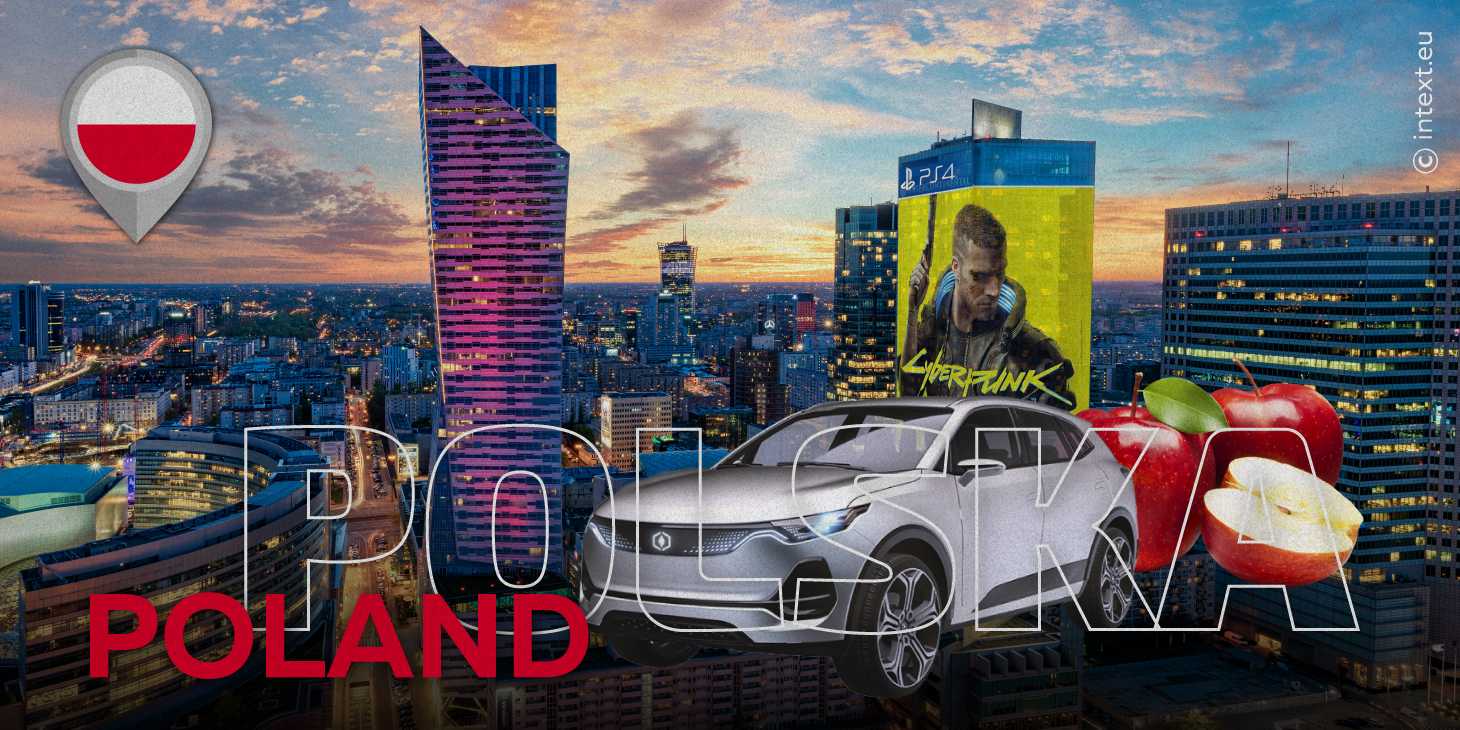07.04.2021
Elena Rudeshko Independent IT and Localization Consultant, writing at the request of InText

Poland has become one of the world’s most successful economies in recent years, achieving one of the longest periods of uninterrupted economic growth in the last few decades. However, being in Poland, you rarely hear about the country’s success from average Poles. So what puts Warsaw, which is geographically equidistant from Washington and Beijing, on the radar of these two economic superpowers?
Geography, consumer market, and labour market
Historically, Poland has enjoyed a favourable geographic location in the centre of Europe along the trade routes connecting the West and the East, today transformed into the New Eurasian Land Bridge. This fastest land route between China and the European Union (EU) has a sound benefit: trains cross only two customs borders (between China and Eurasian Economic Union and the EU). Considering China’s strategic Belt and Road Initiative, Poland constitutes a natural gateway to Western Europe. Other infrastructure projects like the Via Baltica (a road through the Baltic States and Poland) and the Via Carpatia (a highway network connecting the Baltic and Aegean Seas) have the potential to strengthen Poland at a regional level.
A 38-million-strong domestic consumer market comprising 61% of GDP (and exceeding the EU average in 2018) together with membership in the OECD and the EU have made Poland one of the most attractive countries in Central and Eastern Europe (CEE) to foreign investors.
A large pool of highly qualified labour is another competitive advantage. Poland is the third country in the EU by number of tertiary education graduates and by number of graduates in the hard sciences, mathematics, IT, and engineering per 1000 people aged 20 to 29. The combination of a hard-working and well-educated workforce and the sixth-lowest average wages in the EU makes Poland ideal for running a highly profitable operation that maximizes output while keeping costs down.
The Morawiecki plan
In February 2016, then Deputy Prime Minister and Development Minister Mateusz Morawiecki presented his ambitious economic Plan for Responsible Growth with the aim to boost Poland’s growth over the next 15 years and get Poland out of the potential middle-income trap. As a successful managing director of Bank Zachodni WBK in the past, Morawiecki invited to his ministry a young generation of highly skilled managers to focus on innovation, investments, and a new wave of industrialisation. It was a completely new qualitative approach to better governance and administration at the state level.
The government’s implemented social policies have positively fuelled household consumption, which is one of the main drivers of the Polish economy in the mid-term. Moreover, they did not jeopardize the country’s solid fiscal position, with the budget deficit at less than 2% of GDP in pre-COVID times.
Poland was hit economically the least hard among all EU countries by the COVID-19 pandemic, with GDP falling by only 2.8% in 2020. Furthermore, the Polish government forecasts economic growth around 4% of GDP in 2021.
Towards a knowledge-based economy
Following the Morawiecki plan, the government aims to change the Polish mindset from moderate innovation towards research and development, support of high-tech startups, investment in technologies, well-equipped labs, and a green economy. The new law on innovation that entered into force in 2018 grants tax relief and provides better financial support for R&D activities. With a highly motivated technology workforce and newly adopted incentives, Poland is taking advantage of its window of opportunity.
The digital sector is booming. In May 2020, Microsoft announced a $1 billion digital transformation plan for Poland, including access to local cloud services with the first data centre in the region. A month later, Google Cloud announced as much as $2 billion in investment for a data centre in Poland to provide cloud services. January 2021 brought other news: Intel will invest in a completely new laboratory related to artificial intelligence on its premises in Gdansk.
Polish video game development is another flourishing industry. The success of CD Projekt, a Polish company with a market capitalisation of over €5 billion that has surged almost tenfold over the last three years, triggered impressive growth in the number of video game developers in the country. Each fifth game on the wish lists of users of the popular Steam digital distribution service has been developed in Poland.
Made in Poland
A model implemented by the government through systematic identification and active promotion of new competitive Polish brands from 12 the most promising industries with the help of economic diplomacy has supported the foreign expansion of Polish business and attracted the inflow of foreign direct investments into Poland.
Even though Poland is one of the largest European producers of parts for the world’s biggest automotive players and although the automotive sector generated 8% of Polish GDP in 2019, Poland does not have its own automotive brand. However, it seems this is changing. Two prototypes of a Polish electric car by the new Izera brand were introduced to the public in summer 2020, joining a global trend toward e-mobility and with production expected to commence in 2023.
Poland is an important food producer for the EU, with food reaching a total export value of €31.5 billion in 2019. The agri-food sector was one of the fastest-growing in the last decade. Moreover, its export value kept growing even during the most severe turbulence of 2020. Crispy red apples produced in Poland have been the best promoter of the quality of Polish agricultural products since Chinese leader Xi Jinping tasted them during his visit to Warsaw in 2016.
Polish language challenges
With the growing attractiveness of Poland among foreign investors, dynamic development of the digital sector, and Poland’s dominant position in the CEE region as a hub of manufacturing operations, distribution, logistics, and business support services, demand for Polish translations and related localisation services is rising. Polish already became a top 10 language for the video game industry in 2020. And 45 million Polish speakers worldwide is a promising market.
However, Polish is frequently listed among the hardest languages to learn. It is challenging, as even Poles struggle with Polish, making errors in writing and speech. One of the painful issues with localisation into Polish is the length of strings. The translated text could be up to 30% longer than the English, and available space is usually limited. It is therefore crucial to have the right translation and localisation partner with a deep understanding of language-related issues and the peculiarities of entering the Polish market.
___
InText offers Polish translation services.
Explore new markets with our multilingual support.


